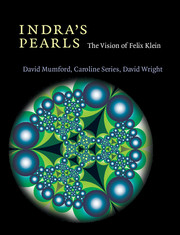Book contents
- Frontmatter
- Contents
- Preface
- Introduction
- 1 The language of symmetry
- 2 A delightful fiction
- 3 Double spirals and Möbius maps
- 4 The Schottky dance pages 96 to 107
- 4 The Schottky dance pages 107 to 120
- 5 Fractal dust and infinite words
- 6 Indra's necklace
- 7 The glowing gasket
- 8 Playing with parameters pages 224 to 244
- 8 Playing with parameters pages 245 to 267
- 9 Accidents will happen pages 268 to 291
- 9 Accidents will happen pages 291 to 296
- 9 Accidents will happen pages 296 to 309
- 10 Between the cracks pages 310 to 320
- 10 Between the cracks pages 320 to 330
- 10 Between the cracks pages 331 to 340
- 10 Between the cracks pages 340 to 345
- 10 Between the cracks pages 345 to 352
- 11 Crossing boundaries pages 353 to 365
- 11 Crossing boundaries 365 to 372
- 12 Epilogue
- Index
- Road map
11 - Crossing boundaries 365 to 372
Published online by Cambridge University Press: 05 January 2014
- Frontmatter
- Contents
- Preface
- Introduction
- 1 The language of symmetry
- 2 A delightful fiction
- 3 Double spirals and Möbius maps
- 4 The Schottky dance pages 96 to 107
- 4 The Schottky dance pages 107 to 120
- 5 Fractal dust and infinite words
- 6 Indra's necklace
- 7 The glowing gasket
- 8 Playing with parameters pages 224 to 244
- 8 Playing with parameters pages 245 to 267
- 9 Accidents will happen pages 268 to 291
- 9 Accidents will happen pages 291 to 296
- 9 Accidents will happen pages 296 to 309
- 10 Between the cracks pages 310 to 320
- 10 Between the cracks pages 320 to 330
- 10 Between the cracks pages 331 to 340
- 10 Between the cracks pages 340 to 345
- 10 Between the cracks pages 345 to 352
- 11 Crossing boundaries pages 353 to 365
- 11 Crossing boundaries 365 to 372
- 12 Epilogue
- Index
- Road map
Summary
Adding the letter ‘c’ to our language
One can grow a little tired of babbling abba—bAABB—aBaa—Baba…. Certainly, language should get far more interesting if we allow c, and then d, and perhaps even e! What we mean is that we should extend our considerations to groups with more than two generators. The algorithm for enumerating the tree of words hardly changes: with a, b and c, we have a six-letter alphabet (because we have to include the inverses A, B and C). In a free group, we must of course avoid cC and Cc; in non-free groups, one would use an automaton to enumerate only the acceptable words in the tree.
Formulas for the matrices for interesting groups with more than two generators are slightly harder to come by. It is true that we can perhaps conjugate the group to obtain formulas with some special symmetry, but in general we have to expect that groups with more than two generators will exhibit much greater variety than two-generator ones.
One way to find formulas is to return to our original framework of Schottky groups and try to find interesting ways to pair up circles in the plane. This is precisely what we did to make the glowing limit set picture on p. xviii; it comes from a group with three generators, arranged as in Figure 11.5.
- Type
- Chapter
- Information
- Indra's PearlsThe Vision of Felix Klein, pp. 365 - 372Publisher: Cambridge University PressPrint publication year: 2002

